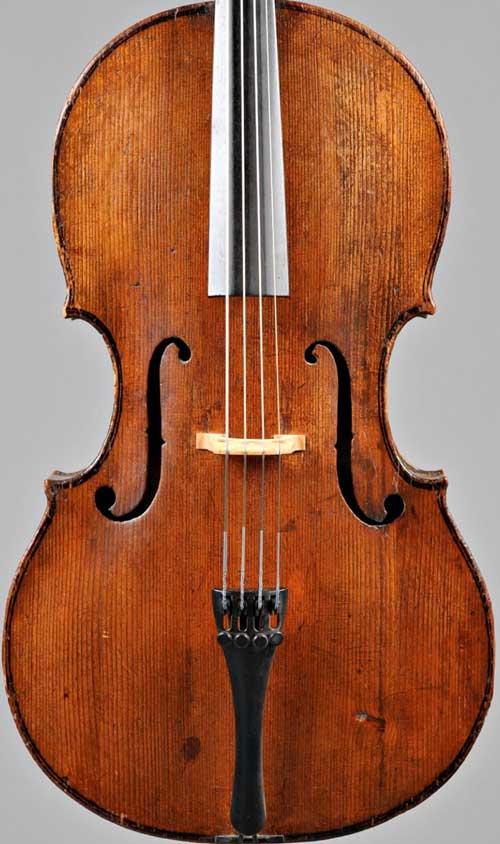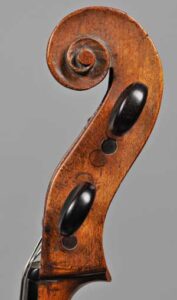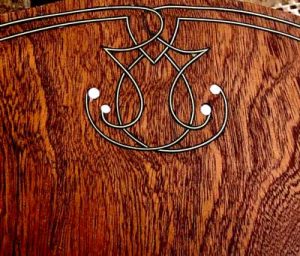The back for the original Grancino attributed instrument is of a very plain, honest Italian Poplar.

Plain, honest, working class!
Milanese makers were certainly not choosy about their wood selection, as a general rule. The plainest of materials however can have spectacular tonal qualities, and even be superior to highly figured woods. However for the past two centuries, great judgement has been unfairly passed upon makers for their wood selection. In Hamma’s exhaustive tome, Meister Italienische Geigenbaukunst, he often writes, “poor choice of wood” – usually when confronted with such plain Jane backs as above. This is, in my mind, a great error, as choosing wood materials solely based upon optical qualities would be a huge mistake.
It may surprise you, that most luthiers do just this! The most expensive wood is usually tiger striped, flamed maple. WHY? The reverse should actually be the case, with the greatest sounding wood priced highest, not the tone wood with the most attractive optical qualities.
Describing sound with words will invariably involve metaphor. This is true not only with sound, but with other subjective experience, such as taste, and smell. Wittgenstein was eternally annoyed by the lack of ‘atomic truth’ in language, and even went so far as to postulate that all philosophical problems, at their source throughout history are really simply semantic disconnections, or the inability to verify private experience. For example, describe the sensation when you see the colors, blue, and white, together. Can you? How would you begin to do so? More importantly, how can you verify that your subjective description is the same as mine?
When describing wines, liquors, cigars, and luxury items, reviewers often use seemingly wild and unlikely metaphors! This carries over into perfumery as well, as when describing the experience of scent, the only reference to a material other than the one being experienced, seems to suffice in communicating subtle differences. What makes a GREAT perfume differ from an ordinary terrible one that your grandmother uses?

Can you combine seaweed and jasmine alcohol tincture? YES!
So in sound it is basically the same. How do we describe the sound of a great instrument with words? How can we make a judgment about the quality of wood, just by looking at it? Think about it! It’s actually quite ridiculous.
I will try and describe the sound I am seeking.
Leathery,
melancholic,
pensive,
and yet with a sharp, clear, crisp and response! Thus the cedar top.
Sapele is a wood with often wild variations in grain density, so the interior reflecting surface with variations in hardness, should give when combined with high, dramatic arching, the beginning foundation for my tonal dreams. Sapele also has very dense, rugged, almost stubborn areas, and in other places, much looser, less dense medullary rays. So in essence when put into vibration, the plate is confused, if you will allow me that metaphor.
What would one give to be in front of Michel Colichon at the very moment he first put his hands upon Cedrela Oderata or, Cigar box Cedar, a.k.a. Spanish Cedar. 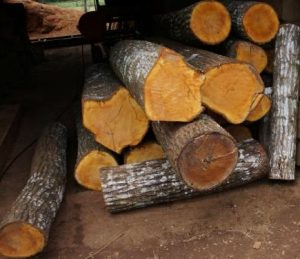 The moniker comes most certainly from the Odori of the wood, which blossoms and is magnified greatly when carved. Cedrela is actually related to the mahogany family of woods, however, is infinitely softer, and lighter in weight. Colichon without question had a very strong intuitive force in imagining the tonal capabilities of this unique material, as he used it for the tops of his instruments, not only the back and ribs. A completely radical experiment in the history of lutherie. His intuition proved correct. All of the Viols made entirely of Cedrela are famous for their very fine tone.
The moniker comes most certainly from the Odori of the wood, which blossoms and is magnified greatly when carved. Cedrela is actually related to the mahogany family of woods, however, is infinitely softer, and lighter in weight. Colichon without question had a very strong intuitive force in imagining the tonal capabilities of this unique material, as he used it for the tops of his instruments, not only the back and ribs. A completely radical experiment in the history of lutherie. His intuition proved correct. All of the Viols made entirely of Cedrela are famous for their very fine tone.
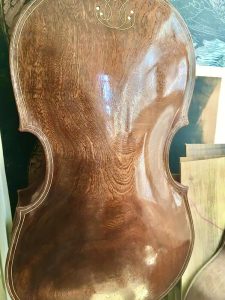
On the lower left bout, highly dense, concentrated grain.
My choice for the back, commonly known as Sapele, not only reflects the dream of sound, but is a humble, honest, Mahogany. One can see how grain density can display large variations even among the same tree, in different areas. It is of the same family, (Meliaceae) as true Mahogany, however this does little to clarify, as the general generic use of the term Mahogany covers hundreds of species, very different from one another.
The name Sapele has quite interesting origins, as its derived of the port city of Sapele in Nigeria, where the wood is most often exported from.where there is a preponderance of the tree. African Timber and Plywood (AT&P), a division of the United Africa Company had a factory at this location where the wood, along with Triplochiton scleroxylon, Obeche, mahogany, and Khaya were processed into timber which was then exported from the Port of Sapele worldwide.
The name of the city itself is said to be an anglicization of the Urhobo word Uriapele, commemorating a local deity. It is believed the British colonial authorities changed the name of the then hamlet to Sapele as it was easier to pronounce.
Sapele is not an expensive wood. Even the highly figured, antique and rare slabs in my workshop are priced the same as plain, straight-grained planks. The resonance and ringing qualities of this wood however are fantastic.
So, in moving forward in the spirit of the Milanese makers, the use of it is a polite nod towards their traditions, and in my mind, perfectly fitting for an inspired instrument based upon the humble original. One notes that each plank has different ringing and note qualities as well, though subtle, based upon oon the swirling, galaxy-like figurines present in the grain.
So then, why use Sapele?
Let us play with the following thought experiment: Imagine yourself in a chamber in which all surfaces are covered in ceramic tile, hence, like a large bathroom. 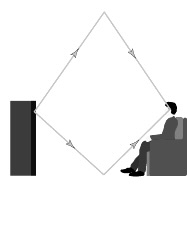 Now imagine you have been given the magical power to change the composition of the surfaces. In the ceramic room, sounds from your voice reflect very quickly back to the ear, and the timbre of sound is something easily imaged. Now you change the surface commotion to steel, tin, or brass. The sound reflection changes as does the actual timbre and character of sound. A softer surface such as leather, would dampen the sound, and even softer such as foam insulation, would kill the reverberation entirely.
Now imagine you have been given the magical power to change the composition of the surfaces. In the ceramic room, sounds from your voice reflect very quickly back to the ear, and the timbre of sound is something easily imaged. Now you change the surface commotion to steel, tin, or brass. The sound reflection changes as does the actual timbre and character of sound. A softer surface such as leather, would dampen the sound, and even softer such as foam insulation, would kill the reverberation entirely.
The back surface of musical instruments perform a double duty as vibrating boards and reflecting surface (as in our imaginary room above) which returns the sound through the F-holes to the listening ear. So the back material for every instrument will have a wide differentiation even among the same species of wood, i.e common maple used for the majority of violin family instruments produced today. Sapele can often display wild differentiations in both density, hardness, and grain distribution, hence its potential as a partial dampening material provides the luthier with a unique challenge and opportunity for expression and control of the reflecting surface.
If one were to begin with a very specific tonal dream in the mind, and move forward using every possible variant which strives to complete and make real the fantasy of sound, then alternative woods make not only absolute sense, but become essential.

